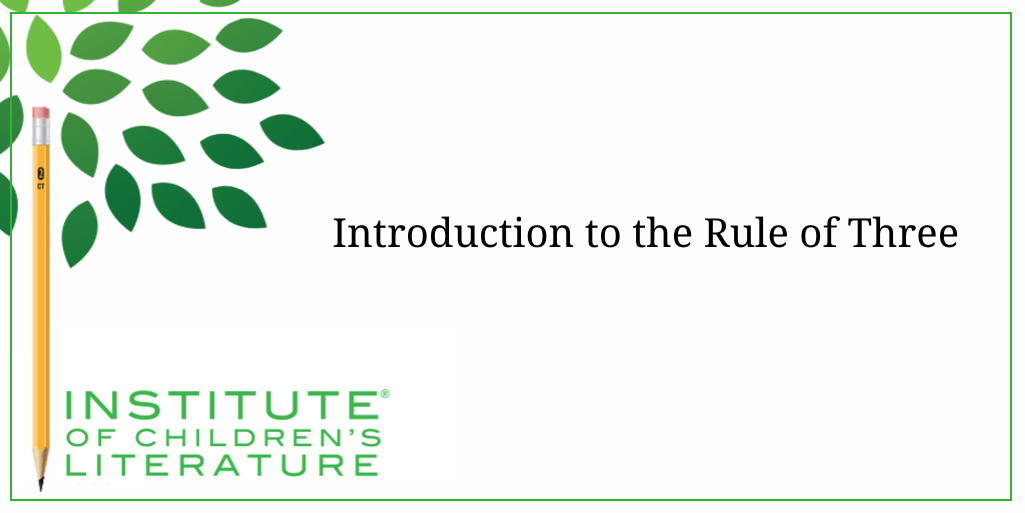
5 Ways Writers Can Prep for 2025 Goal Setting
Before we roll on to the new writing year, let’s harness our optimism for the blank slate before us and prepare for our 2025 Goal Setting just for writers.

Judging by its ubiquity in all forms of storytelling, there is something deeply satisfying about items grouped in threes. Our oldest fairy and folktales abound in threes. Goldilocks encounters three bears. There are three little pigs who are threatened by the big bad wolf. And if you rub a magic lamp, you’re likely to get three wishes.

There are a number of things working in the human enjoyment of things grouped in threes. First, we like patterns. The human brain is always looking for patterns. Paint two spots on a piece of paper and add a third and viewers will see a face because of our natural, hard-wired tendency to seek out patterns that remind us of faces. And patterns require elements. One item isn’t a pattern and two items aren’t quite a pattern. Three is the smallest number of things that form a recognizable pattern. With three, we predict based on the elements because it feels weighty enough to be important.
So, threes make patterns, but there’s more to it than that. Three not only makes a pattern, but it also makes an easily consumable pattern. Because it’s only three, it’s also easy to remember. Items and sentences ordered by the rule of three tend to be more appealing when read aloud because the grouping automatically creates a kind of rhythm as it’s read, and we love rhythm.
Because groupings of three have that element of pattern and therefore prediction to it, it can be subverted to turn the rule of three into comic surprise. The first two items give us a sense of the pattern forming and the third pays off that prediction. But what if it doesn’t? What if it gives us something completely different?

If we passed on the rule of three, we might say, “Madeline was as pretty as a spring morning and as terrifying as a summer storm.” This uses contrast and is effective for that, but it lacks the specificity, the rhythm, and the use of predictability that comes with the rule of three.
Because the rule of three draws the reader into prediction, it can also be used for progression. It moves things. For example, “Jenny looked under her bed; she looked under her dresser; she even looked under her shoes, but all she found was gum.” This set of three demonstrates the character making an effort to solve the plot problem. Thus, it’s an active progression.
Active progression can happen in a single set of things or it can be stretched out into three attempts. For instance, we might be taken along with Jenny as she interrogates three different people to determine whether they are responsible for her missing item. Each might offer a clue. Then when she puts the three clues together, she solves the problem and knows where to find her lost thing.
As we’ve seen, the rule of three isn’t just for items in a sequence. It can pop up all over in storytelling. You might have sets of three lines in a stanza of a poem or three attempts by the main character to solve a puzzle.

Most of us have grown up with the rule of three as part of the stories we’ve heard that we use it without giving it a second thought. It simply feels right to give a character three defining character traits or set him to three tasks. We automatically lean toward the sense of balance and order that comes from this kind of choice. But that doesn’t mean we aren’t benefitted when we pay attention to it.
For instance, when I’ve read stories for critique, and I notice the story drags, I’ll often find the answer in spots where the rule of three was ignored. The character makes four or five attempts before succeeding, or the writer piles in extra core characters that become hard to keep track of. Confusion always drags pace and it’s easy to confuse when too many elements begin appearing.
Because of the ease and pacing that come with the rule of three, I often make it a personal “rule” not to ever have more than three characters in a conversation. With three, I can make each person’s contribution sound different and important, but adding even one more often brings difficulty in reading ease and keeping track of who says what.
The rule of three can also be a fun jumping-off point for writing exercises. For example, think of two items that go well together, then consider a way to subvert the expectation. What third thing could you add that makes sense, but is completely unexpected?
How about you? Come up with some rule-of-three items to string together in ways that make sense but take an unexpected direction at the end. This kind of exercise will sharpen your ability to think outside of the box. And, who knows? It may lead you to a story idea. It’s worked for me more than once.
Give it a try and see where it takes you: a new perspective, a new skill, or a new story. It’s all in the rule of three.
With over 100 books in publication, Jan Fields writes both chapter books for children and mystery novels for adults. She’s also known for a variety of experiences teaching writing, from one session SCBWI events to lengthier Highlights Foundation workshops to these blog posts for the Institute of Children’s Literature. As a former ICL instructor, Jan enjoys equipping writers for success in whatever way she can.

Before we roll on to the new writing year, let’s harness our optimism for the blank slate before us and prepare for our 2025 Goal Setting just for writers.

Writers can be thin-skinned when it comes to getting feedback on their work. Let’s look at 4 ways to positively deal with constructive criticism!

Rejection is part of the territory when it comes to being a writer. Today we offer reflection for writers to help redirect your efforts after a rejection.
1000 N. West Street #1200, Wilmington, DE 19801
© 2024 Direct Learning Systems, Inc. All rights reserved.
1000 N. West Street #1200, Wilmington, DE 19801
© 2024 Direct Learning Systems, Inc. All rights reserved.
1000 N. West Street #1200, Wilmington, DE 19801
© 2024 Direct Learning Systems, Inc. All rights reserved.
1000 N. West Street #1200, Wilmington, DE 19801
© 2025 Direct Learning Systems, Inc. All rights reserved.
1000 N. West Street #1200, Wilmington, DE 19801
©2025 Direct Learning Systems, Inc. All rights reserved. Privacy Policy.
2 Comments